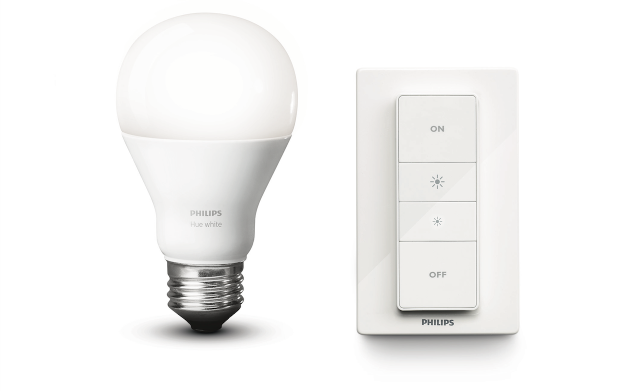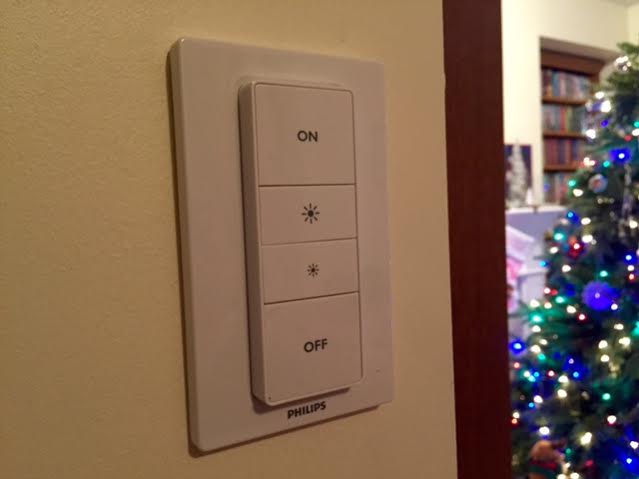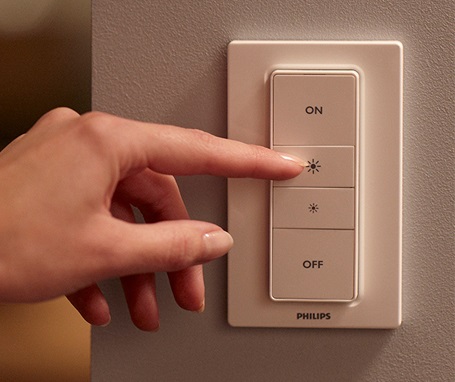 It seems that these days, just about every smarthome subcategory has a “gateway” product. Gateway products are what I define to be a useful smarthome gizmo or gadget that comes at an entry level/introductory price. Some subcategories (like home/garage entry) are impossible to have a gateway product on, but smart lighting shouldn’t be one of them. Thankfully, it no longer is.
It seems that these days, just about every smarthome subcategory has a “gateway” product. Gateway products are what I define to be a useful smarthome gizmo or gadget that comes at an entry level/introductory price. Some subcategories (like home/garage entry) are impossible to have a gateway product on, but smart lighting shouldn’t be one of them. Thankfully, it no longer is.
Philips’ Hue brand is one of the frontrunners in smart lighting and now there’s a great way for you to add to it or introduce yourself to it if you’ve always been interested. The Philips Hue Smart LED Dimmer Kit can help pique your curiosity as fast as you can screw a lightbulb in.
Before I start, I’d like to remind you of some of the usual safety measures you should keep in mind while installing smart lighting: Do not use these bulbs outdoors (unless it is specified for outdoor use) and try to avoid using a socket that has multiple switch inputs attached to it (ie. an entryway light that can be turned on/off from upstairs and downstairs.) The latter is a bit of a throwback caveat of older smart lights and LED light bulbs. However, I’ve yet to see a smart lighting company address this as no longer an issue so I’d still consider it to be.
Most important, however, is not to use the bulb in closed fixtures. In comparison to your standard incandescent light bulbs (if you can even find them anymore,) smart LED bulbs use much less power and emit far less heat. The bulb that comes with this starter kit, for example, runs at 9.5 watts and is still cool to the touch nearly 2 hours after I first placed it in my kitchen table’s light fixture. Still, Philips has said in the past that they’d prefer you don’t put light bulbs like this in a closed fixture. The chances of overheating are unlikely, but let’s not push the envelope when we don’t have to.
How to set up the Philips Hue Smart LED Dimmer Kit
The Dimmer starter kit only consists of 3 pieces: A dimmer switch, a light bulb and the instructions. The instructions aren’t necessary though. Here’s a quick installation summary for you:
- Screw light bulb in
- Pull the battery tab off the remote
- Turn the light switch on
That’s really it. Forgetting the fact that this has smart capability and links up and into the Philips Hue Bridge ecosystem, the “Works out of the box” claim stands. If this is all you intend on using the light for, you’re set. You don’t need to download the Hue app, or have the parenting Bridge device to use this. This is really as simple as the setup is. As a side note, while Philips does sell Hue bulbs that can emit in literally millions of colours, the starter kit contains a white LED bulb with a 25000 hour lifespan. You can also add more bulbs to your home ecosystem as the remote can control and sync up with up to 10 bulbs in total.
A remote comes attached to a base and claims to have a strong 30m signal range to power on/off or dim the lights higher or lower. That claims stands up. No matter what I was doing to try to interrupt the signal, it worked despite my best attempts to thwart it. The base itself is magnetic and can be attached to something that will take it (like the fridge door,) taped or screwed into your wall. The remote can then be used as a faux light switch or detached from the base anytime. The batteries come pre-installed in the remote so you won’t have to run for the toolbox just to get this thing going. Most importantly, the light bulb’s emission is committed to the bulb’s memory. This means that if you turn the light off with the remote, it will come back on with however dim or bright you’d left it at.

However, your light bulb must always have a constant source of power for the remote and its features to work. What this means is that the second you power off at the light switch, you can’t use your remote to power back on/off or dim. The bulb’s memory also resets the moment you shut off at the main source meaning that if you were to remote dim and then turn the light off at the switch, it will come back on at default settings when you flip the switch on again.
It works better as part of the Hue Network
 If you are curious about how this cooperates with the rest of the Hue network, the short answer is that it plays well with its siblings. You will, however, require a Philips Hue Bridge in order to have better control of the bulbs in the way you’d expect to have control of a smart lighting system. Syncing to the bridge will give you access to the usual run of the mill capabilities you can expect: Timers, connection to the other Hue gadgets and even connection to the third party capabilities like the Works with Nest program. Should you pair it with the Bridge, you will also have the ability to create your own set of rules and regulations in the Hue app. Otherwise, your features are restricted to whatever the remote does. This may be fine for the majority of you. My dad, for example, won’t need more than the dimming and power features. My mom, however, might want to set her lights on timers when she’s away for the weekend. She’ll find use from the the fancier features Bridge synchronization offer.
If you are curious about how this cooperates with the rest of the Hue network, the short answer is that it plays well with its siblings. You will, however, require a Philips Hue Bridge in order to have better control of the bulbs in the way you’d expect to have control of a smart lighting system. Syncing to the bridge will give you access to the usual run of the mill capabilities you can expect: Timers, connection to the other Hue gadgets and even connection to the third party capabilities like the Works with Nest program. Should you pair it with the Bridge, you will also have the ability to create your own set of rules and regulations in the Hue app. Otherwise, your features are restricted to whatever the remote does. This may be fine for the majority of you. My dad, for example, won’t need more than the dimming and power features. My mom, however, might want to set her lights on timers when she’s away for the weekend. She’ll find use from the the fancier features Bridge synchronization offer.
The nice part about expanding your horizons and adding the Hue bridge is that it is no longer as costly as it used to be. If this product were released a year or two ago, you’d be staring down around $200 to get everything going. Nowadays, the Philips Hue A19 Smart LED Starter Kit is much less, though the Multicolour Starter Kit will still run you about that.
A great Introduction to Smart Lighting
Smart Lighting isn’t going to be for everybody, but it doesn’t mean one shouldn’t be able to try it without taking a steep hit to the wallet. In the Philips Hue Smart LED Dimmer Kit, you have a great starter product that you can build on without breaking the bank and should you ever decide to make it a full-time thing for your home, you can incorporate it into an existing system without having to replace everything. It’s a great addition to any living room, bedroom and/or kitchen and it’s available now.



My Hue bulbs are one of my favourite smart home gadgets. I have the multicolor bulbs and they’re a hoot now that it’s Christmas. I downladed OnSwitch and we’re having so much fun with the Santa and candlelight theme.
Comments are closed.